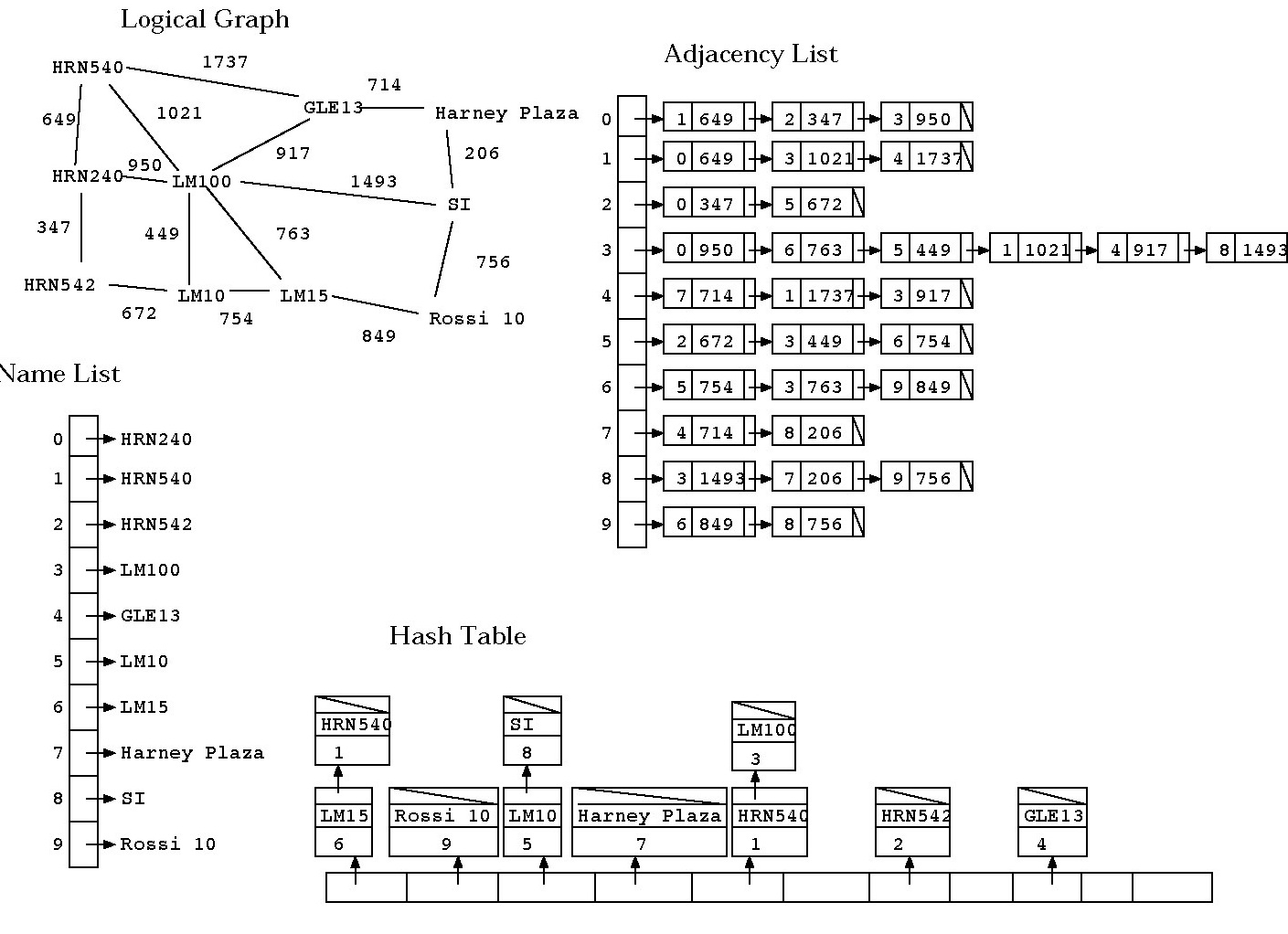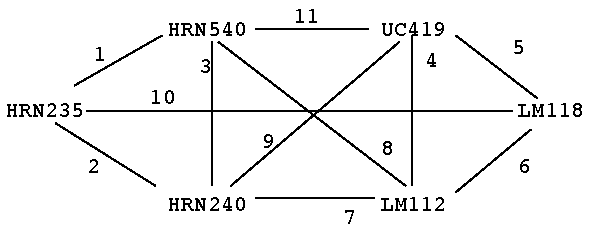Computer Science 245
Spring 2015
Bonus Project: Spanning Trees
Due Wednesday, May 13th, 2015
For your bonus final project, you can implement Kruskal's algorithm
for finding a minimal cost spanning tree. This project will combine Graphs,
Kruskal's algorithm, Disjoint sets, Hash Tables and Lists (whew!). Successfull completion of this project
can add up to 50 points to your projects grade.
Nodes with Labels
For this assignment, each vertex in the graph will be labeled with an
arbitrary string. How can we run Kruskal's algorithm when the vertices
are not integers? First, we will assign an integer to each vertex
string (the easiest way to do this is to assign the first string we see
to 0, the second string we see to 1, etc). We can then store the vertex
strings in an array, where the index of the array is the number that we
assign to the vertex string stored at that index. For instance, if the
data contains the vertex names “HRN 240”, “LM
206” and “GLE 14”, we can assign 0 to “HRN 240”
(storing the string “HRN 240” at
index 0 of our array), assign 1 to “LM 206” (storing the string
“LM 206” at the index 1 of our array) and we can
assign 2 to “GLE 15” (storing the string “GLE 14” at
index 2 of our array). Now, given any number n, it
is easy to find the appropriate string assigned to that number (by
looking at index n in our array).
How can we get an index given a string? One method would be to search
through our entire array looking for the appropriate string. A better
solution (and the solution that you are required to use for this
assignment) is to create a hash table to store the vertex string /
vertex number combinations. You can use the vertex string as the key to
enter the vertex number into the hash table (so each hash table entry
will have a vertex number data value, and a string key value). You can
use any hashig strategy that you wish, though you might find that open
hashing is slightly easier to implement. Note that you are
not allowed to use any built-in hash table functionality in Java, you
will need to write the hash table yourself!
Implementing the Graph
One you have created your array of vertex names and your hash table to
look up vertex numbers, you are ready to build the graph. Your graph
need not contain any information about which vertex number is assigned
to which node string – that information can be kept entirely
in you node string array and your hash table. You will find the hash
table quite useful when creating the graph, however!
Kruskal's Algorithm
Once you have your graph, your are ready to run Kruskal's Algorithm.
Enter all of the edges into a list, and then sort it based on the
edge cost. Then repeatedly remove the smallest edge,
check to see if it will cause a cycle (using your disjoint set data
structure), and add it to the spanning tree if it does not cause a
cycle (also updating the disjoint set)
Disjoint Sets
Your implementation of Kruskal's algorithm will use disjoint sets.
Your implementation of Disjoint Sets should use union-by-rank and path
compression for maximum efficiency. See the Disjoint Set notes for
more details.
Quick Overview of Data Structures
So, while Kruskal's algorithm is running, you will have the following data
structures:
- Graph (Adjacency List)
- List used to associate vertex numbers with vertex names
- Hash table used to associate vertex names with vertex
numbers
- List of edges
Disjoint Set arrat
Thus, just before you start running Prim's algorithm,
your data structures might look something like:

Input File Format:
The data file will have the following format:
- A list of the vertex labels in the graph, one per line./li>
- A line containing the single character “.”
- A list of edges in the following form:
- First endpoint of the edge, on a single line
- Second endpoint of the edge, on a single line
- Cost of the edge (integer) on a single line
The graphs for this project are undirected, so if there is an
edge between vertices ``A'' and ``B'' in the graph with a cost of 4,
then either
Thus, the graph:

could be represented by the input file:
HRN235
HRN540
HRN240
UC419
LM112
LM118
.
HRN235
HRN540
1
HRN540
HRN240
3
HRN240
HRN234
2
LM118
HRN245
10
HRN240
UC419
9
HRN240
LM112
7
HRN540
LM112
8
LM112
UC419
4
LM118
LM112
6
UC419
LM118
5
HRN540
UC419
11
Note that there is more than one way to represent this graph, since
each edge can be represented in one of two ways, (V1, V2) or (V2, V1),
and the edges and vertices can be listed in any order.
Program Output:
Your program should read in the graph from an input file specified by
a command line argument and then:
- Print out the graph that was read in, in an adjacency list
format (using vertex names, not numbers)
- Print out a separating line
- Run Kruskal's algorithm to find a minimum cost spanning tree
- Print out this minimum cost spanning tree (using the same
format)
Thus, a legal output for the input file above would be:
Original Graph
HRN235 HRN540 1, HRN240 2, LM118, 10
HRN540 HRN235 1, HRN240 3, LM112 8, UC419 11
HRN240 HRN235 2, HRN540 3, UC419 9, LM112 7
UC419 HRN540 11, HRN240 9, LM112 4, LM118 5
LM112 HRN240 7, HRN540 8, UC419 4, LM118 6
LM118 UC419 5, HRN235 10, LM112 6
---------------------------------
Kruskal
HRN235 HRN540 1, HRN240 2
HRN540 HRN235 1,
HRN240 HRN235 2, LM112 7
UC419 LM112 4, LM118 5
LM112 HRN240 7, UC419 4
LM118 UC419 5
There is more than one legal output, since the adjacency lists can be
in any order. This particular example has only one valid MST -- if a
graph has multiple valid MSTs, you only need to find one of them. Note that you
need two entries in the adjacency list for each edge in an
undirected graph.
Project Submission
Submit all files required to run your project to:
https://www.cs.usfca.edu/svn/<username>/cs245/Bonus/
You can have any class names you like, as long as the main function is
in a class named SpanningTree.
Random Details
- Do not use any Java library classes in this project
(specifically, don't use any hash table classes!) Yes, when
you are coding "for real" you will be using libraries, but the point of
this class is for you to understand how those libraries work.)
- This is a largish project, which will require several
classes. Start early!
- You have a fair amount of freedom as to how to arrange your
code, how many classes to create, and so on. I am available
for consultation if you have any questions.
- Although you may use as many different classes as you like,
and call your classes whatever you like, the main program needs to be
in a class named SpanningTree, and the input file name needs to be read from
the command line. Output should be written to standard out.
You will lose points if your program does not meet these
restrictions.
- Write pieces of your project (like the hash table) and test them separately before combining them into the
final project.
- Code Reuse is your friend. For instance, you should have one
piece of code to print out a graph, and use that code for all three
times that a graph needs to be printed out

